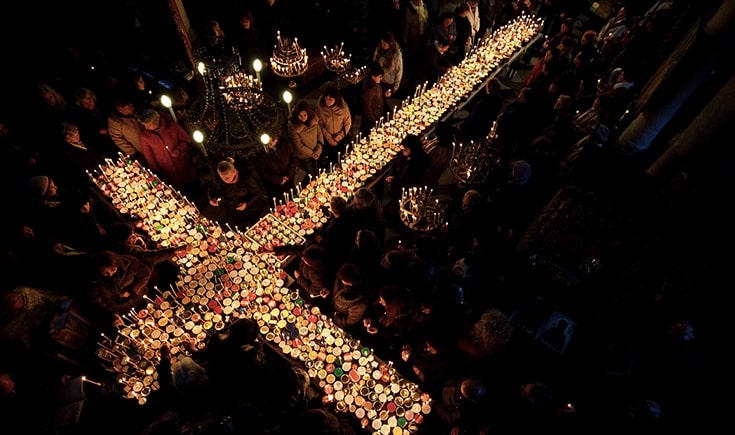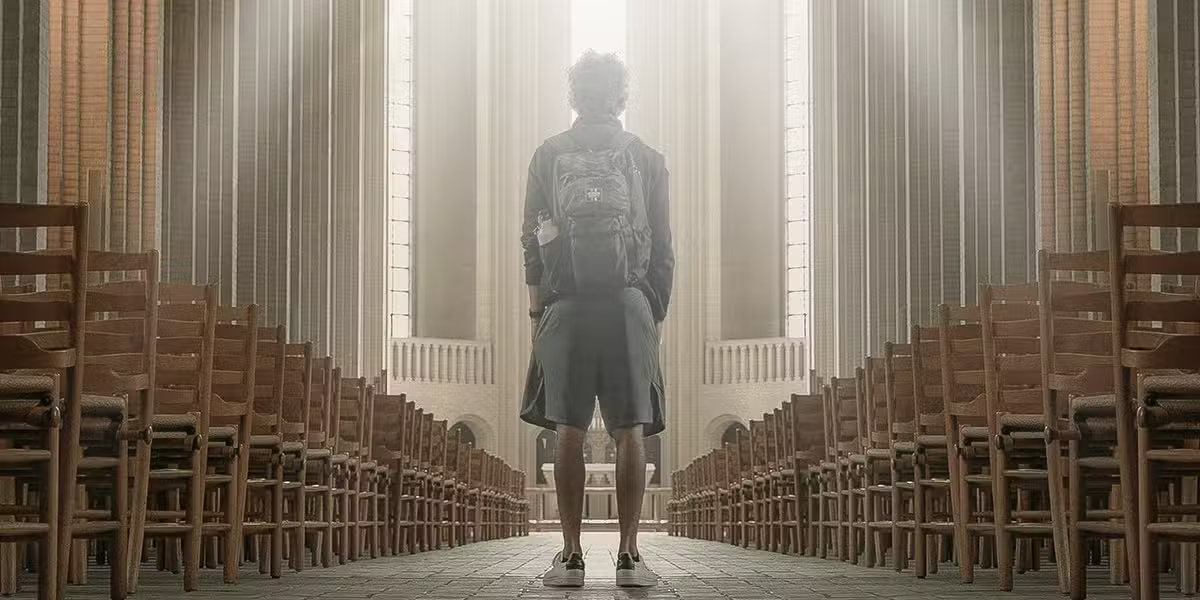Christ died on the cross so we may have help carrying our own.
She was young, attractive, athletic, dressed in spiffy, hot-pink tennis duds—and crying. As other members of her tennis team gathered around sympathetically, the woman explained that she was “too enmeshed” with her son, a bright boy who had serious problems with social and motor skills.
He was going off independently to school, and she groaned, “My whole life was taking care of him–because if I didn’t do it, he’d have chaos. I don’t know what I’ll do now!” She continued that she was also concerned about her mom, an elderly woman who lived far away and insisted on driving when she shouldn’t.
“What if she has an accident and kills or hurts someone?” the woman asked, tearfully. A classic case of the sandwich generation, I thought, trying not to be too obvious about eavesdropping.
The consolation from the others came swiftly:
“Well, at least you have tennis!”
“Oh, that’s my therapy,” replied the woman.
I’d never criticize another person’s coping mechanism, especially for one confronting such tough issues. But I secretly longed for this woman to participate in our parish celebration of Good Friday that evening. It might have soothed some of her pain, or at least put it into the context of Christ’s suffering. Many wise traditions know the importance of naming one’s loss or sorrow, since suppressing it only makes it worse. Buddhist monk and author Thich Nhat Hanh suggests cradling our broken hearts as tenderly as we would a sick and crying child.
In a particularly Catholic way, abstraction such as “suffering” is translated to tangible, visible word and gesture in the liturgy. Furthermore, it links our individual stories and struggles concretely, not just verbally, to the overarching story of Christ’s redemptive suffering.
My rule of thumb for Good Friday liturgy is this: when we do something only once a year, pay attention. So I focus on three parts of the service that move me especially.
The Presider’s Prostration
Liturgy, at its best, speaks through symbol or gesture, not needing many words to convey meaning. For instance, submersion in the waters of Baptism, lighting the Easter candle, or offering a cup of wine all speak eloquently without verbiage. The Good Friday service begins with a silent procession, and the presider prostrating himself before the altar. We see this action only once a year: What does it say?
Different people probably have different interpretations at different times of their lives. To me, it says, starkly, “We killed God.” Not to become morbid, but to some extent we are all guilty. We have killed that divine spark in each other, through a callous word, a harsh condemnation, a heavy hand.
The presider speaks for all of us as he lies face-down on the floor. “This, my friends, is what we’ve done to the finest human/divine being who ever lived.”
Words can’t touch the tragedy: symbolically, we all lie flat on our faces.
The Readings: Psalm 22
The first verbal nugget was the taunting line from the reading: “You relied on the LORD—let him deliver you; if he loves you, let him rescue you” (Ps 22:9). If God loves you?
Jesus, who began praying this psalm from the cross, must have suffered the ultimate abandonment: doubt that his Father—who had always been a source of joy and strength—loved him. Fully human, not just play-acting, he descended to the depths of human exile. Yet the psalms have a remarkable way of pirouetting from one emotion to another, often from depth to peak.
Kathy McGovern presents a positive interpretation in her blog “The Story and You.” After Jesus, in agony, calls out the beginning verse: “My God, my God, why have you abandoned me?,” some women “standing at a distance” respond, in synagogue style to his introduction by reciting the rest of it, all 31 verses, including the triumphant end, when the suffering one proclaims that ‘all will proclaim the Lord to generations still to come, his righteousness to a people yet unborn.’
“Jesus relies on ‘those standing at a distance’—and that’s us, too, isn’t it?—to finish the psalm for him, including lines that in the context of the crucifixion are a tribute to prayer under the worst conditions: ‘you who fear the Lord, praise him.'”
At some unspoken depth, Jesus knows that, ultimately, it all ends well, as God had planned.
The Passion of the Cross
The reading from the Passion according to John follows Jesus from his questioning by Annas, the high priest, to the praetorium where he is tried by Pontius Pilate. The time frame for most of Chapter 18 occurs at night.
After the Last Supper, Jesus goes to the garden in darkness. Judas comes with soldiers bearing lanterns and torches. They then bring him to the court of Annas. There, Peter’s denials occur by the charcoal fire; it is still night. But John 18:28 records, “it was morning.” That raises the question, where did Jesus spend the night?
Scripture scholar McGovern gives a fascinating talk about Holy Week, with slides taken in the Holy Land. One of her most vivid descriptions is of a dark, spidery, terrifying pit. Prisoners who’d been taken into custody were lowered into it by pulleys and kept chained there so they wouldn’t kill themselves before their trials. It is most likely, she concluded, that Jesus would have spent the night before his trial by Pilate in this dank dungeon.
The light of the world was plunged into terrible darkness and chained there. What were Jesus’ thoughts? Clearly, he wouldn’t have been able to sleep much. Did he pray? Did he console other prisoners? Did he remember his friends at their last meal together, or think of his mother? It’s an unrecorded part of the narrative. We can only imagine what happened.
But it might bring tremendous consolation for people trapped in various addictions, imprisoned, or victimized in the countless ways humans torture each other to know that Jesus endured what they do. He who was beauty, grace, freedom, and compassion was chained to a filthy wall. He who had never hurt anyone felt the raw bite of metal into his skin. He who had such clarity about his mission did not know what horror the morning might bring. He entered deeply into the worst of being human.
Veneration of the Cross
People seemed drawn to the crucifix: to touch it lightly, cling to a hand, or kiss the feet. What is the compelling power of this instrument of death, used by Romans over 2,000 years ago? As our pastor pointed out, it’s not the cross; it’s the corpus. To simply revere the cross would be like honoring Martin Luther King Jr. by hanging up an assault rifle.
Father Richard Rohr describes the corpus in Wondrous Encounters: Scripture for Lent: “Jesus’ body is a standing icon of what humanity is doing and what God suffers ‘with,’ ‘in,’ and ‘through’ us. It is an icon of utter divine solidarity with our pain and our problems.”
Each person who approached it that evening bore some kind of sorrow. And they were only a few, representing millions more outside our church. Scratch the surface of any group and you’ll find the tragedies. In a family, a staff, or a work site, the stories of suffering run deep. Add in the veterans of Iraq or Afghanistan, the physical and mental aftermaths of war and the ripple effect on their families—an immense tide of suffering crashed at the foot of the crucifix.
Those who venerated the cross came close to the crucified Jesus to find meaning in their own burdens. Connecting their pain to his meant that they didn’t suffer alone. Wave after wave of people in vast variety approached: the lovely couple whose daughter died last year in a freak accident; the vulnerable elderly who could barely bend to touch it; a woman battling cancer; the wife of an Iraq veteran addicted to painkillers; an obese woman whose childhood hungers still drove her to eat, jeopardizing her health.
The children were especially touching, quietly extending their thin arms, and perhaps whispering, “I’m sorry, Jesus, that you had to die like this.” Knowing his magnificent courtesy, Jesus would somehow touch those who touched his cross.
I wondered about the tennis player I’d seen that morning. Would it help her to be part of this movement toward a God who suffered? Would she feel an affinity to the Christ whose first words to Mary Magdalene did not trumpet his resurrection, but probed her sorrow: “Woman, why are you weeping?” (Jn 20:15). Participating in the liturgy wouldn’t end the lady’s suffering. But it would give her the support of a suffering God, and companions who endure and seek to transform their pain.









1 thought on “Darkness & Light: A Good Friday Reflection”
I remember once hearing that crosses should be adorned with jewels or painted flowers and joyous art designs to announce the resurrection and the power of God over death – even the terrible death by crucifixion. I understand that sentiment, for the description of what death by crucifixion entails is gruesome. And, yet, the meditation of the “corpus” of Jesus on the cross brings home the suffering of all humanity.
I was in Santa Rosa de Copan, Honduras, with a tour group. We were looking at a oil painting in a church which depicted a Roman Centurian piercing the crucified Jesus’ side with a lance. Blood and water were seen flowing from the wound. A young Honduran woman standing with us asked me what that meant. I embarked on a scholarly explanation of the physiological details of what a crucified victim endures: the pain, the weakness, the inability to hoist one’s body up to breathe, the eventual building up of fluid in the lungs, the asphyxiation, and death by a kind of strangulation. I went on to explain that was why, when the centurian pierced Jesus’ side, that build-up of water flowed out as well as blood. I turned to look at the women and saw that she was weeping copiously.
Whenever I look at Jesus on the cross today, I remember not only what crucifixion entailed, but how humanity ought to weep over what we did to Jesus and what we do to our fellow human beings.